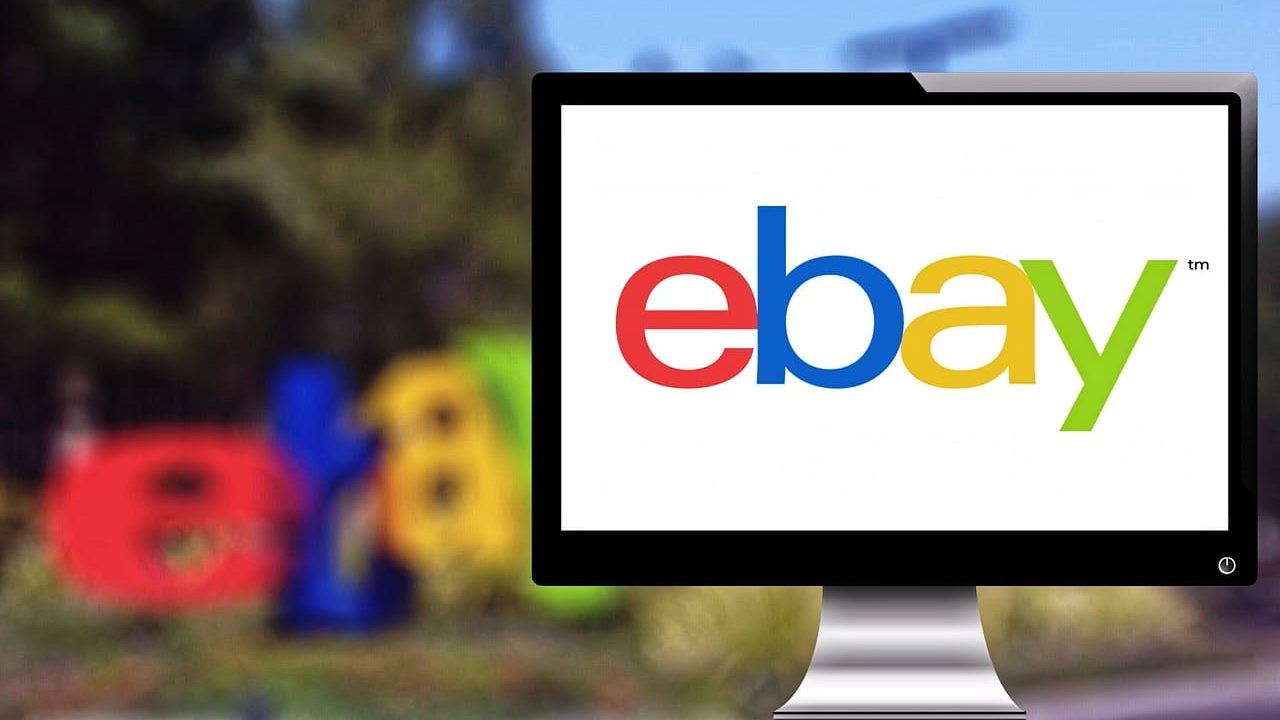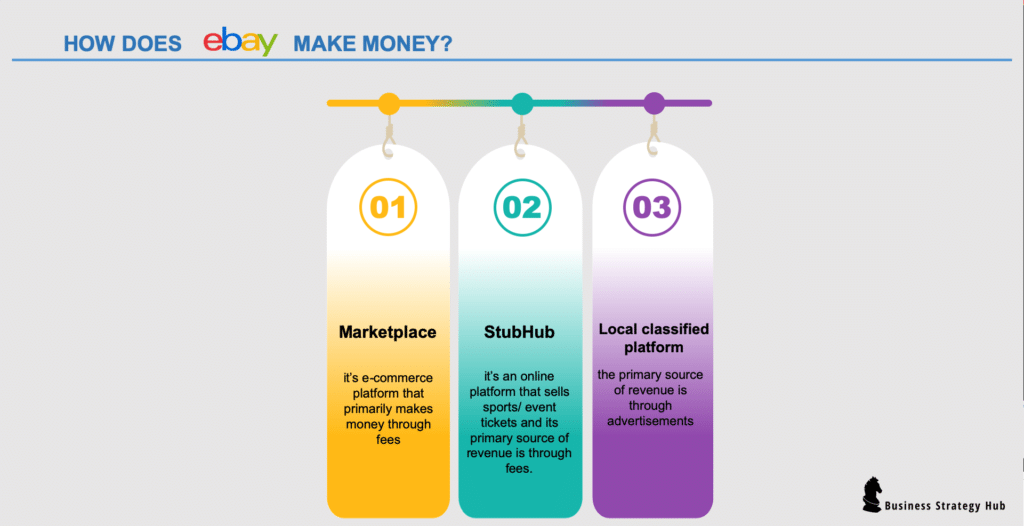Last updated: May 23, 2020
Company: eBay
Founder: Pierre Omidyar
CEO: Devin Wenig
Year founded: 1995
Headquarter: San Jose, California, USA
Number of Employees (Dec 2019): 13,300
Type: Public
Ticker Symbol: EBAY
Market Cap (May 2020): $30.53 Billion
Annual Revenue (Dec 2019): $10.80 Billion
Profit |Net income (Dec 2019): $1.79 Billion
Products & Services: eBay Stores Markdown Manager | StubHub | New promotion Boxes Feature for eBay Stores | Free Shipping | eBay MapIt | My World | Skype Buttons | eBay Pop | eBay Deal Finder |
Competitors: Alibaba | Walmart | Amazon | JD | Etsy | Rakuten | Zalando | Groupon | Facebook Marketplace | Flipkart | OLX | Craiglist | Shopify sites | Letgo | Offerup
Fun Fact: In 2019, eBay has over 180 million active buyers with over $ 90 billion of annual global merchandise volume.
Having more than 180 million active users, eBay is considered as the world’s second-largest retailer. Many business owners have already sought to capitalize on eBay’s effective marketplace in order to expand their customer base.
It provides the perfect platform for business owners to sell their products and ensure that it receives ample exposure. This drives the sales value of the product and ensures its purchase.
Customers are usually wary of online purchasing and for a good reason. Many turn out to be inauthentic, and eBay stands out as an exception. It has a mechanism in place where customers enjoy protection from poor services and scams. Their safety and security is a topmost priority for eBay which is why it is such a trusted entity worldwide.
eBay’s best benefit by far is how its sellers have access to its shipping savings procedure. Their lowering of shipping costs makes their services all the more appealing to buyers and sellers alike.

How does eBay make money?
eBay Inc. is a global commerce company. eBay’s revenue model is based on three main divisions:
- Marketplace – it’s e-commerce platform that primarily makes money through fees
- StubHub – it’s an online platform that sells sports/ event tickets and its primary source of revenue is through fees.
- Local classified platform – the primary source of revenue is through advertisements
Let’s discuss them in more detail:
1. eBay Marketplace
eBay has already made its mark in online trading. Now, people to people trading has been made more convenient especially when the trading process of a digitized nature. This process has set the stage of the next evolutionary trading standards which were usually carried out in garage sales or at flea markets.
On eBay, trading happens at either a fixed price or as an auction. In the case of an auction, it can be of two types.
- First being the buyer’s auction, which is utilized by buyer’s who wish to buy a single product.
- The other is the seller auction where the sellers make a bid for their product in a variety of offers from which the buyer can choose from.
eBay has gone on to produce exclusive features such as eBay Top Rated Seller Program, eBay Money Back Guarantee, Verified Rights Owner Program, Feedback Forum, eBay Top Rated Seller Program and the Safe Harbor Program for both buyers and sellers alike.
The purpose of these features is to ensure that their customers feel secure enough to trade with their partners who they prefer to remain undisclosed.
“Buy It Now” is considered as the simplest way to trade on eBay. Most marketplaces already utilize this method online. You can use Buy It Now in three different ways.
- If you find the Buy It Now option in the Auction-style listings, you can purchase it directly or choose to bid in the auction yourself. The distinction will be that the Buy It Now Price will be higher than the initial price of the auctions in at least 30%.
- If you find the Buy It Now option in the Reserve Price auctions, your option will only be shown once you meet the official reserve price.
- The last option is Buy It Now without any bidding. Customers can buy any products they prefer at a given price. This is common in every e-commerce company.
Many of these provided features are free of cost to buyers. However, the sellers will be charged according to a fixed price.
Insertion Fee:
It’s the money that eBay charges to the sellers for listing their products on its platform.
If a seller lists their article on eBay, he will be charged an insertion fee. The fee varies according to the item category and is charged per listing.
Zero Insertion fees listings – Every seller on eBay is given at least 50 free listings per month. The platform then charges sellers for every additional listing after providing them with the first free 50 listings.
For Movies, Music, DVDs, Video Games and Books, the price is fixed for 5 cents. For any other category, it can range up to 30 cents per listing.
Final Value Fee (FVF):
It’s the money that eBay charges sellers when their product is sold.
If a seller makes a sale on its platform, eBay will charge a commission for it. The commission ranges from 2% to 12% of the total sales price and is charged by the name of Final Value Fee. The commission can vary depending on the category of the item or products. Also, there could be optional upgrade fees and more based on the different categories.

2. StubHub
In 2007, eBay took over StubHub. It operates as an enterprise that specializes in online ticket exchanges that provides an opportunity to buy and sell sports, concerts or theater event tickets. Owing to its increasing popularity, it went to become the world’s largest ticket provider.
Sellers Fees – While listing the tickets is free for sellers, they do have to pay for 15% of the ticket’s sales price at the time of sale. The number of tickets being sold by the seller is also a factor in reducing its fees. If the sold ticket numbers are met, the seller could see a 10% decrease in costs.
Buyers Fees – StubHub charges a service and delivery fees from its buyers which is about 10% of the sales price. All these fees are subject to change based on the popularity of the event, location, availability, etc.
3. Classified Platforms
Much of eBay’s local online trading objectives are given to its local classified platform subsidiary. On these classified platforms, eBay makes money primary through advertisement. Its model is similar to Craigslist’s business model as well as Letgo’s business model. Some of the local classified subsidiaries are:
- Bilbasen – Online Vehicle Marketplace in Denmark
- BDA – A popular classified ads site in Denmark
- 2dehands-2ememain – an online platform to sell the second-hand item in Belgium
- eBay Kleinanzeigen – online platform for Germany
- Gumtree – an online platform for UK, Australia, Singapore, South Africa
- Kijiji – A classifies ads site for Canada and Italy
- MarketPlaats – Online platform for the Netherlands
- Mobile.de – popular vehicle marketplace in Germany
- Motor.co.uk – Popular car search website in the UK
- Vivanuncios – online retail market place in Mexico
Final Word
It is clear that eBay will continue to make strides in the online business hemisphere. Although it is not a giant like Amazon in terms of dominance, it still remains as one of the most popular online retailers available.
All it needs to do is makes itself more accessible to a broader demographic and enter different markets in terms of the continent, and it can catch up to Amazon in no time.
Tell us what you think? Did you find this article interesting?
Share your thoughts and experiences in the comments section below.













Add comment